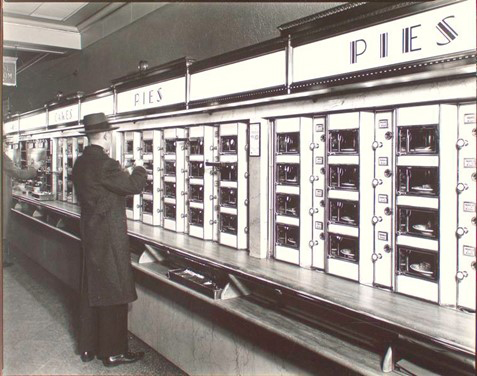The Automat Concept – What’s Old Is New Again With Technology: Opportunity for Hotels
Co-authored by Isaiah Morrow, MBA Student, The School of Hotel and Restaurant Management, The W.A. Franke College of Business, Northern Arizona University
A restaurant without waiters or workers behind the counter seems like an idea from the future; Ironically, this is an idea of the past. This concept is called an Automat, it was popularized in the early 1900s after the Spanish Flu Pandemic (Figure 1). Horn & Hardart, the largest Automat opened in New York in 1912 without any visible employees' whatsoever costumers inserted their money into a glass-enclosed kiosk and enjoyed a steaming plate of freshly made food (Strauss, 2019). The Automat trend lastly untiled earlier 1990s were the last Horn & Hardart finally went out of business in 1991.
The Coronavirus Pandemic may give the Automat concept another opportunity to thrive. In a time where contactless pickup is a buzzword Brooklyn Dumpling Shop, a tech-forward startup thinks Automat's are the future of restaurants. Brooklyn Dumpling Shop plans to open its doors in Manhattan in December 2020 (Figure 2). Brooklyn Dumpling Shop menu will feature 32 dumpling varieties along with spring rolls, beverages, and desserts (Guszkowski, 2020). Customers will order via phone or in-store kiosk, receive a notification when their dumplings are ready, and pick up their meal from temperature-controlled cubbies accessed by scanning a code on their phone (Guszkowski, 2020).
In a statement, Dan Rowe, the CEO of Fransmart said "This is the right concept at the right time—high volume, small footprint, tech-forward, fully co-packed menu built for speed, accuracy, and incredible taste." Easta, a San Francisco Startup thought the same thing a few years ago. Eatsa opened in 2015, offering inexpensive, mostly vegetarian breakfast and lunch (Figure 3). Customers ordered by tapping on iPad kiosks, retrieving their meals through small lockers whose high-tech screens lit up with customers' names (Pershan, 2019). Eatsa has been closed since the spring of 2019 after thousands of dollars of unpaid rent. Eatsa has rebranded as Brightloom as part of its transition to offer an end to end digital flywheel solution to the restaurant industry (Pershan, 2019).
The automat concept could benefit the lodging industry. As Americans look for safe ways to enjoy holiday trips, spring break, and summer vacation; the travel industry seeks innovative ways to encourage travel. The Automat could be a concept that a hotel can incorporate on their onsite restaurants to facilitate safe and low contact dining. As well be an earlier adopter of bringing the Automat concept back from the past.
Works Cited
- Guszkowski, J. (2020, November 16). Brooklyn dumpling shop to franchise its modern automat concept. Retrieved from Restaurant Business: https://www.restaurantbusinessonline.com/technology/brooklyn-dumpling-shop-franchise-its-modern-automat-concept
- Pershan, C. (2019, July 18). Automated Quinoa Restaurant Owes Thousands in Unpaid Rent. Retrieved from Eater: https://sf.eater.com/2019/7/18/20699066/eatsa-closed-sf-unpaid-rent-landlord-automat
- Strauss, B. (2019, February 10). The Rise and Fall of the Automat. Retrieved from ThoughtCo.:
https://www.thoughtco.com/the-rise-and-fall-of-the-automat-4152992





